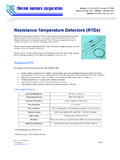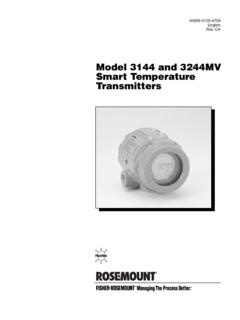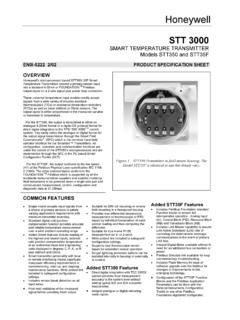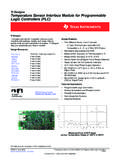Transcription of ACTIVE STATOR WINDING THERMAL …
1 ACTIVE STATOR WINDING THERMAL protection FOR AC MOTORS Pinjia Zhang Student Member, IEEE Georgia Institute of Technology 777 Atlantic Dr Atlanta, GA 30332 USA Bin Lu Senior Member, IEEE Eaton Corporation 4201 North 27th Street Milwaukee, WI 53216 USA Thomas G. Habetler Fellow, IEEE Georgia Institute of Technology 777 Atlantic Dr Atlanta, GA 30332 USA Abstract AC motors are the main workhorses in process industries. Their malfunction may not only lead to repair or replacement of the motor, but also cause significant financial losses due to unexpected process downtime. Reliable THERMAL protection of ac motors is crucial for reducing the motor failure rate and prolonging a motor s lifetime. In this paper, conventional THERMAL protection devices and state-of-the-art THERMAL protection techniques are reviewed with their advantages and limitations discussed.
2 Since 2001, the research team at the author s company and at the Georgia Institute of Technology has been cooperatively developing a series of ACTIVE motor THERMAL protection methods, as a low-cost alternative approach to the traditional passive and sensor-based methods. These ACTIVE THERMAL protection methods monitor the average STATOR temperature via STATOR resistance estimation based on the dc equivalent model of ac motors, using only motor STATOR voltage and current measurements. In this paper, an overview of the ACTIVE THERMAL protection techniques for line-started, soft-starter-connected and inverter-fed ac motors is presented, with their advantages and drawbacks discussed. The ACTIVE THERMAL protection techniques are capable of providing accurate, and non-invasive THERMAL protection of ac motors.
3 Index Terms AC motor, inverter, starter, STATOR resistance, STATOR temperature, temperature estimation, THERMAL protection . I. INTRODUCTION In North America, ac motor systems play a critical role in industrial process, while consuming more than a half of all the electric power produced. Due to their effectiveness, ruggedness and low maintenance requirements, these ac motors are widely used in applications of pumps, fans, mills, compressors, etc. The malfunction of a motor may not only lead to the repair or replacement of the individual motor, but also cause significant financial losses due to unexpected process downtime. Therefore, reliable motor protection is essential for minimizing the motor failure rate, increasing the mean time to a destructive motor breakdown, and prolonging a motor s lifetime.
4 Over the years, substantial efforts have been made in developing preventive monitoring and protection techniques for ac motors. As an important feature of any motor protection system, THERMAL protection is crucial for avoiding THERMAL overload and prolonging a motor s lifetime. As one of the major underlying root causes of motor failures, THERMAL overload can lead to deterioration of key components of a motor, including STATOR WINDING insulation, bearing, motor conductors, and core, etc [1-5]. The STATOR insulation is typically the most vulnerable component during THERMAL overload, since its THERMAL limit is reached before that of any other motor component. About 35-40% of induction motor failures are related to STATOR WINDING insulation failure [1-3].
5 STATOR insulation failures are normally the results of long-term THERMAL aging [6]. A high STATOR WINDING temperature, which also depends on the insulation class, gradually and irreversibly reduces the electrical and mechanical performance of the insulation materials due to chemical reactions, and eventually leads to insulation failures. The typical THERMAL limits of the STATOR WINDING for different insulation classes are listed in Table I [7]. As a rule of thumb, it is estimated that a motor s life is reduced by 50% for every 10 C increase above the STATOR WINDING temperature limit. Therefore, a motor must be de-energized immediately when the THERMAL limit is reached. As a result, accurate and reliable THERMAL protection of ac motors is essential for prolonging a motor s lifetime and preventing unexpected process downtime.
6 TABLE I. TEMPERATURE LIMITS FOR DIFFERENT INSULATION CLASSES. Insulation Class Ambient Temperature ( C) Rated Temperature Rise ( C) Hot Spot Temperature ( C) A 40 60 105 B 40 80 130 F 40 105 155 H 40 125 180 Motor THERMAL overload is typically caused by the following reasons [8]: 1. transient/starting THERMAL overload; 2. motor overload; 3. unbalanced supply voltages; 4. high ambient temperature; 5. impaired cooling capability. (a) unbalanced supply voltage (b) overload Fig.
7 1. STATOR WINDING damage due to THERMAL overload [9]. PRESENTED AT THE 2009 IEEE IAS PULP & PAPER INDUSTRY CONFERENCE IN BIRMINGHAM, AL: IEEE 2009 - PERSONAL USE OF THIS MATERIAL IS PERMITTED. The STATOR WINDING damages caused by unbalanced supply voltage and overload are shown in Fig. 1 (a) and (b), respectively. It can be observed that the STATOR WINDING may be totally damaged due to THERMAL overload. Since the start of the utilization of ac motors, THERMAL protection has drawn special attention due to the relatively severe consequences of STATOR insulation failures. To preventively protect the motor from STATOR WINDING insulation failure and extend a motor s lifetime, the STATOR WINDING temperature often needs to be continuously monitored during operation.
8 Such monitoring is particularly important for medium- to large-size motors due to relatively larger capital costs the costs of the associated process downtime due to unexpected failures. Direct measurements of the STATOR WINDING temperature using embedded THERMAL sensors, such as thermocouples, resistance THERMAL detectors (RTDs), infrared THERMAL sensors, etc, are the most reliable approach for THERMAL protection . However, their applications are limited due to economic reasons, especially for small- to medium-size motors, since the installations of the embedded THERMAL sensors are difficult and costly. Many different types of THERMAL protection devices have become commercially available, which by design are not directly measuring the motor temperature.
9 Their operating principles and drawbacks are discussed in Section II and III. The basic concept of an alternative type of THERMAL protection techniques: ACTIVE THERMAL protection techniques, is presented in Section IV. The ACTIVE THERMAL protection techniques for line-started, soft-starter-connected, and inverter-fed ac motors, which are previously proposed by the authors, are summarized and compared in Sections V, VI, and VIII, respectively. Their advantages and drawbacks are also discussed. The ACTIVE THERMAL protection techniques are capable of providing accurate and non-invasive THERMAL protection of ac motors. II. CONVENTIONAL THERMAL protection DEVICES Fig. 2. Typical THERMAL limit curve [10]. The most commonly used conventional motor THERMAL protection devices are: dual-element time-delay fuses and eutectic alloy or bi-metal type overload relays.
10 Motor THERMAL protection in industry typically relies on using a combination of these devices. They are designed based on the THERMAL limit curves, which define the safe operating time for different magnitudes of input currents under both transient and running overload conditions. The typical THERMAL limit curve of an ac motor is shown in Fig. 2 [10]. Although these low-cost THERMAL protection devices have been proven to work over the years, they can only roughly emulate the THERMAL limit curve. Besides, even the THERMAL limit curve is also only a rough and conservative representation of the THERMAL characteristic of ac motors, since the effects of ambient temperature, unbalanced supply voltage and the changes of the cooling capability of ac motors are neglected.


















